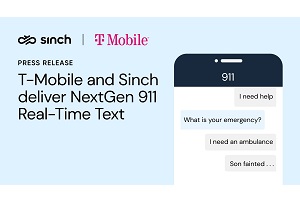T-Mobile, Sinch deliver NextGen 911 real-time text to make fast access to public safety support easier for customers

Bellevue and Chicago, United States – With a vast majority of the estimated 240 million 911 calls made in the U.S each year coming from a wireless device, fast and reliable connectivity in an emergency matters. T-Mobile has been at the forefront of public safety connectivity solutions like location-based routing and NextGen 911 because every second counts and instant communication with 911 telecommunicators can save lives.
And now that leadership continues as the un-carrier partners with Sinch, the cloud communications platform solutions provider, to launch another important: NextGen 911 real-time text (RTT).
This next generation 911 RTT technology is now operating at an emergency communications centre (ECC) in Hood County, Texas, allowing T-Mobile customers to communicate with 911 through simultaneous conversational text and voice text messages can be sent and read at the same time without the need for teletype (TTY) technology. This is particularly critical for up to 48 million Americans who are deaf or hard of hearing, as well as those who have speech-related disabilities or are non-native English speakers. RTT also gives public safety centres the ability to make better-informed dispatch decisions during a crisis and shave crucial time off a response.
T-Mobile built native RTT features into its devices in 2016, which gives customers the ability to utilise modern conversational text capabilities and allows a text to be sent and read at the same time without the need to hit send or use a specialised device. Then in 2020, the Un-carrier became the wireless provider to launch location-based routing and next generation 911 (NG911) connectivity over IP two critical advancements that can speed up emergency response times by helping pinpoint the location of callers and enable a more efficient and effective 911 system. These advancements paved the way for fully enabling NextGen 911 RTT for 911 callers in Hood County, Texas and eventually beyond.
Now, as public safety answering points (PSAPs) across the U.S. are ready, they can update TTY to more modern systems to help reduce inaccuracies and improve emergency response. T-Mobile’s advanced network with end-to-end IP connectivity and Sinch’s public safety-grade connectivity provide the foundation for NG911 capabilities, available in 24 States, with plans to expand RTT nationwide as public safety answering points (PSAPs) prepare to deploy the new technology.
“RTT 911 provides an enhanced service to our community including Deaf, hearing or speech impaired individuals as well as those who want to use RTT,” says Christy Williams, director of 911, North Central Texas Emergency Communications. “We appreciate the support of T-Mobile, Sinch, and Solacom as well as our ECCs and staff in implementing production operational practices. We hope carriers and PSAPs around the country become RTT ready to improve public safety.”
“T-Mobile’s advanced LTE network and nationwide 5G network enables game changing technologies like this industry-leading NextGen 911 RTT that will help people and public safety centres communicate more quickly and more clearly in a crisis – and ultimately save lives,” says Neville Ray, president of technology at T-Mobile. “As the Un-carrier we’re always committed to solving pain points and creating better experiences – never more important than when it comes to ensuring customers and public safety centres have dependable connections in emergencies.”
“Real-time texting is an important advancement because it allows the requestor and receiver to type at the same time and saves precious seconds, which are critical to successfully managing emergency calls and protecting the community,” says Chandy Ghosh, general manager and chief operating officer of emergency services at Sinch. “The extensive collaboration we achieved working with T-Mobile helped in delivering potent next generation capabilities to increase the accuracy of information relayed to PSAPs and first responders. It also creates a clear path to NG911 for other public safety jurisdictions.”
Comment on this article below or via Twitter @IoTGN
